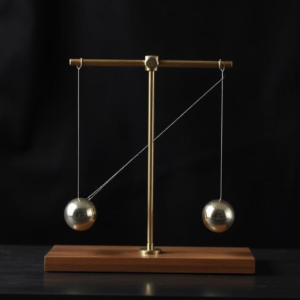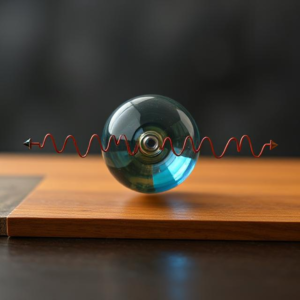Simple Pendulum
What is a Simple Pendulum?
A simple pendulum is a mass attached to a string or rod that swings back and forth under the influence of gravity. It moves in a regular, repeating motion called oscillation.

How Does It Work?
- Setup: Imagine a weight (the bob) hanging from a string. When you pull the bob to one side and let it go, gravity pulls it back down, and the bob swings to the other side.
- Motion: The bob swings from side to side in a curved path, and the motion continues in a regular way as long as there’s no energy loss (like from air resistance).
- Key Point: The time it takes for the bob to swing from one side to the other and back (called the period) depends on the length of the string and the force of gravity, but not on the weight of the bob.
Simple Pendulum Formula
The period
(time for one complete swing) of a simple pendulum can be calculated using this formula:
Where:
is the period (time for one complete oscillation).
is the length of the string.
is the acceleration due to gravity (9.8 m/s² on Earth).
The period is independent of the mass of the bob, which means that heavier or lighter objects take the same time to swing (as long as we ignore air resistance).
Real-World Examples:
- Clocks: Many older mechanical clocks used a simple pendulum to keep time.
- Metronomes: Devices used by musicians to keep a steady beat.
Double Pendulum
What is a Double Pendulum?
A double pendulum consists of two simple pendulums, one attached to the end of the other. This system is more complex than a single pendulum because it involves two masses and two strings, making it behave in a more chaotic way.
How Does It Work?
- Setup: The first pendulum has a bob attached to a string. The second pendulum is attached to the end of the first one, and it also has its own bob and string.
- Motion: When the first pendulum swings, it causes the second pendulum to swing as well. The motion of both pendulums is coupled, meaning that the motion of one affects the other.
- Chaotic Behavior: Unlike the simple pendulum, which moves in a regular, predictable way, the double pendulum exhibits chaotic motion. This means that its motion is very sensitive to initial conditions, and small differences in starting position can lead to very different results over time.
Key Points:
- The double pendulum has two degrees of freedom, making it much more complicated than a simple pendulum.
- Its motion is nonlinear and can be difficult to predict over long periods, which is why it’s often used as an example of chaos theory.
- Chaos means that even small changes in the starting position can lead to dramatically different movements, making it difficult to predict.
Real-World Examples:
- Some mechanical systems (like certain machinery with linked parts) behave similarly to a double pendulum.
- It also serves as a model for understanding more complex systems in physics and engineering.
Coupled Oscillations
What are Coupled Oscillations?
Coupled oscillations happen when two or more oscillating systems (like pendulums or springs) are connected in such a way that they influence each other’s motion. This means that the motion of one system is connected to the motion of the other(s).
How Does It Work?
- Coupling: In coupled oscillations, two or more objects are connected by a spring or a string (or some other force), and they oscillate together.
- For example, if you have two pendulums attached by a string, they will influence each other’s motion as they swing back and forth.
- Energy Transfer: When one oscillating system moves, it transfers energy to the other system(s). As a result, the objects can synchronize or exchange energy, creating different types of motion.
- Types of Coupled Motion:
- In the case of two pendulums, one might start to swing in a certain direction, and then the energy will transfer to the other pendulum, causing it to swing as well. Depending on how the systems are coupled, this can lead to different behaviors:
- In-phase motion: Both pendulums swing in the same direction at the same time.
- Out-of-phase motion: The pendulums swing in opposite directions.
- In the case of two pendulums, one might start to swing in a certain direction, and then the energy will transfer to the other pendulum, causing it to swing as well. Depending on how the systems are coupled, this can lead to different behaviors:
Key Points:
- Normal Modes: When two or more oscillating systems are coupled, they can have normal modes of oscillation where both systems swing in synchrony or in opposition.
- Energy Transfer: In coupled oscillations, energy is constantly transferred between the oscillating systems.
- Resonance: Coupled oscillations can also lead to resonance, where the systems oscillate with larger amplitudes when the natural frequencies match.
Real-World Examples:
- Tuning Forks: If you strike one tuning fork, the sound can make another tuning fork nearby start vibrating due to the coupled oscillations of sound waves.
- Coupled Spring Systems: Two springs connected to each other will affect each other’s motion, especially when they’re tuned to similar frequencies.
Summary
- Simple Pendulum: A basic pendulum with one mass on a string, swinging back and forth. The period depends on the length of the string and gravity, not on the mass of the bob.
- Double Pendulum: A system of two pendulums connected in series. It exhibits chaotic and unpredictable behavior, often used to study chaos theory.
- Coupled Oscillations: Multiple oscillating systems (like pendulums or springs) that are connected and influence each other’s motion. They can synchronize or transfer energy, leading to different patterns of motion.
Each of these systems shows different types of motion, from the regular and predictable swinging of a simple pendulum to the complex and chaotic behavior of coupled systems.











